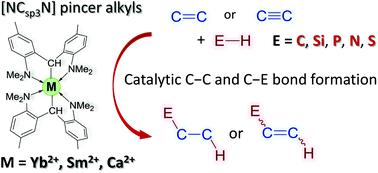当前位置:
X-MOL 学术
›
Inorg. Chem. Front.
›
论文详情
Our official English website, www.x-mol.net, welcomes your
feedback! (Note: you will need to create a separate account there.)
Ln(II) and Ca(II) NCsp3N pincer type diarylmethanido complexes – promising catalysts for C–C and C–E (E = Si, P, N, S) bond formation
Inorganic Chemistry Frontiers ( IF 6.1 ) Pub Date : 2020-05-12 , DOI: 10.1039/d0qi00369g Dmitry O. Khristolyubov 1, 2, 3 , Dmitry M. Lyubov 1, 2, 3 , Andrey S. Shavyrin 1, 2, 3 , Anton V. Cherkasov 1, 2, 3 , Georgy K. Fukin 1, 2, 3 , Alexander A. Trifonov 1, 2, 3, 4, 5
Inorganic Chemistry Frontiers ( IF 6.1 ) Pub Date : 2020-05-12 , DOI: 10.1039/d0qi00369g Dmitry O. Khristolyubov 1, 2, 3 , Dmitry M. Lyubov 1, 2, 3 , Andrey S. Shavyrin 1, 2, 3 , Anton V. Cherkasov 1, 2, 3 , Georgy K. Fukin 1, 2, 3 , Alexander A. Trifonov 1, 2, 3, 4, 5
Affiliation

|
Ln(II) (Ln = Yb, Sm) and Ca(II) [NCsp3N] pincer type diarylmethanido complexes [2,2′-(4-MeC6H3NMe2)2CH]2M (M = Yb (2), Sm (3), Ca (4)) coordinated by a tridentate diarylmethanido ligand were synthesized through salt metathesis reactions of {[2,2′-(4-MeC6H3NMe2)2CH]K(THF)}2 and MI2(THF)2. X-ray analysis revealed that both diarylmethanido ligands in 2–4 are tridentate and coordinate to the metal centers via central carbon and two nitrogen atoms of NMe2 groups resulting in [NCsp3N] pincer coordination. In one of the five-membered MCCCN metallacycles in each tridentate diarylmethanido ligand, metal–arene interactions were detected and the coordination mode of [NCsp3N] ligands in 2–4 can be classified as κ1-N:η4-CCCN. A dynamic behavior involving the exchange between NMe2 groups and THF molecules in the coordination sphere of the M(II) ion was detected in solution. Complexes 2–4 proved to be catalytically active in a variety of reactions of C–C and C–E (E = Si, P, N, S) bond formation. Yb(II) 2 and Ca(II) 4 complexes catalyze intermolecular hydrobenzylation of styrene with 2-methyl and 2,6-dimethyl pyridines. Complex 2 demonstrates high chemo- and regioselectivities and is the first Ln(II) catalyst for intermolecular C–C bond formation. Complexes 2–4 were found to be efficient and selective precatalysts for intermolecular hydroelementation of olefins and acetylenes with various EH substrates (E = Si, P, N, S). Complexes 2–4 have demonstrated their versatility for intermolecular C–E bond formation and allow the realization of hydroamination, hydrophosphination, hydrosilylation and hydrothiolation of styrene and phenylacetylene. Moreover, 2–4 were found to be active in the catalysis of challenging transformations such as hydrosilylation and hydrophosphination of internal double C![[double bond, length as m-dash]](https://www.rsc.org/images/entities/char_e001.gif) C and triple C
C and triple C![[triple bond, length as m-dash]](https://www.rsc.org/images/entities/char_e002.gif) C bonds.
C bonds.
中文翻译:

Ln(II)和Ca(II)NCsp3N钳型二芳基甲酰胺基络合物–有望形成C–C和C–E(E = Si,P,N,S)键的催化剂
Ln(II)(Ln = Yb,Sm)和Ca(II)[NC sp 3 N]钳型二芳基甲酰胺基络合物[2,2'-(4-MeC 6 H 3 NMe 2)2 CH] 2 M(M = Yb(2),Sm(3),Ca(4))由三齿二芳基甲酰胺基配体通过{[2,2'-(4-MeC 6 H 3 NMe 2)2 CH] K( THF)2和MI 2(THF)2。X射线分析表明,两个二芳基甲酰胺配体在2-4中是三齿的,并通过中心碳和NMe 2基团的两个氮原子与金属中心配位,从而导致[NC sp 3 N]钳位配位。在每个三齿配体diarylmethanido的五元MCCCN metallacycles之一,金属-芳烃进行检测的相互作用和协调模式[NC SP 3 N]在配体2-4可以被分类为κ 1 -N:η 4 -CCCN 。在溶液中检测到了动态行为,该行为涉及NMe 2基团与THF分子在M(II)离子配位域中的交换。配合物2-4证明在C–C和C–E(E = Si,P,N,S)键形成的各种反应中具有催化活性。Yb(II)2和Ca(II)4络合物催化苯乙烯与2-甲基和2,6-二甲基吡啶的分子间加氢苄基化。配合物2具有较高的化学和区域选择性,是第一个形成分子间C-C键的Ln(II)催化剂。发现配合物2–4是用于烯烃和乙炔与各种EH底物(E = Si,P,N,S)的分子间加氢元素化的高效且选择性的预催化剂。配合物2-4已证明它们具有分子间C–E键形成的多功能性,并可以实现苯乙烯和苯乙炔的加氢胺化,加氢磷酸化,加氢甲硅烷基化和加氢硫醇化。此外,发现2–4在具有挑战性的转化(例如内部双C![[双键,长度为m-破折号]](https://www.rsc.org/images/entities/char_e001.gif) C和三C
C和三C ![[三重键,长度为m-破折号]](https://www.rsc.org/images/entities/char_e002.gif) C键的氢化硅烷化和氢磷酸化)的催化中具有活性。
C键的氢化硅烷化和氢磷酸化)的催化中具有活性。
更新日期:2020-06-30
![[double bond, length as m-dash]](https://www.rsc.org/images/entities/char_e001.gif) C and triple C
C and triple C![[triple bond, length as m-dash]](https://www.rsc.org/images/entities/char_e002.gif) C bonds.
C bonds.
中文翻译:

Ln(II)和Ca(II)NCsp3N钳型二芳基甲酰胺基络合物–有望形成C–C和C–E(E = Si,P,N,S)键的催化剂
Ln(II)(Ln = Yb,Sm)和Ca(II)[NC sp 3 N]钳型二芳基甲酰胺基络合物[2,2'-(4-MeC 6 H 3 NMe 2)2 CH] 2 M(M = Yb(2),Sm(3),Ca(4))由三齿二芳基甲酰胺基配体通过{[2,2'-(4-MeC 6 H 3 NMe 2)2 CH] K( THF)2和MI 2(THF)2。X射线分析表明,两个二芳基甲酰胺配体在2-4中是三齿的,并通过中心碳和NMe 2基团的两个氮原子与金属中心配位,从而导致[NC sp 3 N]钳位配位。在每个三齿配体diarylmethanido的五元MCCCN metallacycles之一,金属-芳烃进行检测的相互作用和协调模式[NC SP 3 N]在配体2-4可以被分类为κ 1 -N:η 4 -CCCN 。在溶液中检测到了动态行为,该行为涉及NMe 2基团与THF分子在M(II)离子配位域中的交换。配合物2-4证明在C–C和C–E(E = Si,P,N,S)键形成的各种反应中具有催化活性。Yb(II)2和Ca(II)4络合物催化苯乙烯与2-甲基和2,6-二甲基吡啶的分子间加氢苄基化。配合物2具有较高的化学和区域选择性,是第一个形成分子间C-C键的Ln(II)催化剂。发现配合物2–4是用于烯烃和乙炔与各种EH底物(E = Si,P,N,S)的分子间加氢元素化的高效且选择性的预催化剂。配合物2-4已证明它们具有分子间C–E键形成的多功能性,并可以实现苯乙烯和苯乙炔的加氢胺化,加氢磷酸化,加氢甲硅烷基化和加氢硫醇化。此外,发现2–4在具有挑战性的转化(例如内部双C
![[双键,长度为m-破折号]](https://www.rsc.org/images/entities/char_e001.gif) C和三C
C和三C ![[三重键,长度为m-破折号]](https://www.rsc.org/images/entities/char_e002.gif) C键的氢化硅烷化和氢磷酸化)的催化中具有活性。
C键的氢化硅烷化和氢磷酸化)的催化中具有活性。











































 京公网安备 11010802027423号
京公网安备 11010802027423号